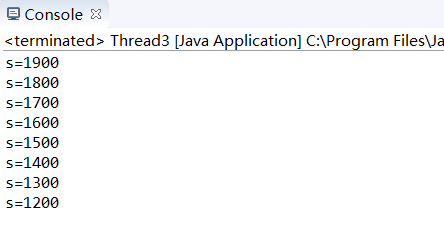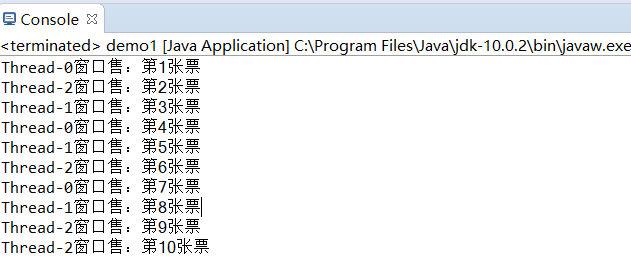馮志霞201771010107《面向物件程式設計(java)》第十七週學習總結
---恢復內容開始---
實驗十七 執行緒同步控制
實驗時間 2018-12-10
1、實驗目的與要求
(1) 掌握執行緒同步的概念及實現技術;
(2) 執行緒綜合程式設計練習
2、實驗內容和步驟
實驗1:測試程式並進行程式碼註釋。
測試程式1:
l 在Elipse環境下除錯教材651頁程式14-7,結合程式執行結果理解程式;
l 掌握利用鎖物件和條件物件實現的多執行緒同步技術。

package synch; /** * This program shows how multiple threads can safely access a data structure. *View Code@version 1.31 2015-06-21 * @author Cay Horstmann */ public class SynchBankTest { public static final int NACCOUNTS = 100; public static final double INITIAL_BALANCE = 1000; public static final double MAX_AMOUNT = 1000; public static final int DELAY = 10; public static void main(String[] args) { Bank bank= new Bank(NACCOUNTS, INITIAL_BALANCE); for (int i = 0; i < NACCOUNTS; i++) { int fromAccount = i; Runnable r = () -> { try { while (true) { int toAccount = (int) (bank.size() * Math.random());double amount = MAX_AMOUNT * Math.random(); bank.transfer(fromAccount, toAccount, amount); Thread.sleep((int) (DELAY * Math.random())); } } catch (InterruptedException e) { } }; Thread t = new Thread(r); t.start(); } } }

package synch; import java.util.*; import java.util.concurrent.locks.*; /** * A bank with a number of bank accounts that uses locks for serializing access. * @version 1.30 2004-08-01 * @author Cay Horstmann */ public class Bank { private final double[] accounts; private Lock bankLock; private Condition sufficientFunds; /** * Constructs the bank. * @param n the number of accounts * @param initialBalance the initial balance for each account */ public Bank(int n, double initialBalance) { accounts = new double[n]; Arrays.fill(accounts, initialBalance); bankLock = new ReentrantLock(); sufficientFunds = bankLock.newCondition(); } /** * Transfers money from one account to another. * @param from the account to transfer from * @param to the account to transfer to * @param amount the amount to transfer */ public void transfer(int from, int to, double amount) throws InterruptedException { bankLock.lock(); try { while (accounts[from] < amount) sufficientFunds.await();//當迴圈條件有不滿足的情況時需要用到條件物件 System.out.print(Thread.currentThread());//獲得當前執行緒名 accounts[from] -= amount; System.out.printf(" %10.2f from %d to %d", amount, from, to); accounts[to] += amount; System.out.printf(" Total Balance: %10.2f%n", getTotalBalance()); sufficientFunds.signalAll();//喚醒所有執行緒 } finally { bankLock.unlock(); } } /** * Gets the sum of all account balances. * @return the total balance */ public double getTotalBalance() { bankLock.lock(); try { double sum = 0; for (double a : accounts) sum += a; return sum; } finally { bankLock.unlock(); } } /** * Gets the number of accounts in the bank. * @return the number of accounts */ public int size() { return accounts.length; } }View Code

測試程式2:
l 在Elipse環境下除錯教材655頁程式14-8,結合程式執行結果理解程式;
l 掌握synchronized在多執行緒同步中的應用。
package synch2;
import java.util.*;
/**
* A bank with a number of bank accounts that uses synchronization primitives.
* @version 1.30 2004-08-01
* @author Cay Horstmann
*/
public class Bank
{
private final double[] accounts;
/**
* Constructs the bank.
* @param n the number of accounts
* @param initialBalance the initial balance for each account
*/
public Bank(int n, double initialBalance)
{
accounts = new double[n];
Arrays.fill(accounts, initialBalance);
}
/**
* Transfers money from one account to another.
* @param from the account to transfer from
* @param to the account to transfer to
* @param amount the amount to transfer
*/
public synchronized void transfer(int from, int to, double amount) throws InterruptedException
{
while (accounts[from] < amount)
wait();
System.out.print(Thread.currentThread());
accounts[from] -= amount;
System.out.printf(" %10.2f from %d to %d", amount, from, to);
accounts[to] += amount;
System.out.printf(" Total Balance: %10.2f%n", getTotalBalance());
notifyAll();
}
//與加鎖過程基本相同,此時只需對方法體用 synchronized關鍵字修飾即可,無需在建立條件物件,其中notifyAll();與signalAll();作用一致
/**
* Gets the sum of all account balances.
* @return the total balance
*/
public synchronized double getTotalBalance()
{
double sum = 0;
for (double a : accounts)
sum += a;
return sum;
}
/**
* Gets the number of accounts in the bank.
* @return the number of accounts
*/
public int size()
{
return accounts.length;
}
}
執行結果與測試一相同
測試程式3:
l 在Elipse環境下執行以下程式,結合程式執行結果分析程式存在問題;
l 嘗試解決程式中存在問題。
| class Cbank { private static int s=2000; public static void sub(int m) { int temp=s; temp=temp-m; try { Thread.sleep((int)(1000*Math.random())); } catch (InterruptedException e) { } s=temp; System.out.println("s="+s); } }
class Customer extends Thread { public void run() { for( int i=1; i<=4; i++) Cbank.sub(100); } } public class Thread3 { public static void main(String args[]) { Customer customer1 = new Customer(); Customer customer2 = new Customer(); customer1.start(); customer2.start(); } } |
class Cbank
{
private static int s=2000;
public synchronized static void sub(int m)
{
int temp=s;
temp=temp-m;
try {
Thread.sleep((int)(1000*Math.random()));
}
catch (InterruptedException e) { }
s=temp;
System.out.println("s="+s);
}
}
class Customer extends Thread
{
public void run()
{
for( int i=1; i<=4; i++)
Cbank.sub(100);
}
}
public class Thread3
{
public static void main(String args[])
{
Customer customer1 = new Customer();
Customer customer2 = new Customer();
customer1.start();
customer2.start();
}
}

實驗2 程式設計練習
利用多執行緒及同步方法,編寫一個程式模擬火車票售票系統,共3個視窗,賣10張票,程式輸出結果類似(程式輸出不唯一,可以是其他類似結果)。
Thread-0視窗售:第1張票
Thread-0視窗售:第2張票
Thread-1視窗售:第3張票
Thread-2視窗售:第4張票
Thread-2視窗售:第5張票
Thread-1視窗售:第6張票
Thread-0視窗售:第7張票
Thread-2視窗售:第8張票
Thread-1視窗售:第9張票
Thread-0視窗售:第10張票

import java.util.concurrent.locks.Lock; import java.util.concurrent.locks.ReentrantLock; public class Demo1{ public static void main(String[] args) { demo d = new demo(); Thread t1 = new Thread(d); Thread t2 = new Thread(d); Thread t3 = new Thread(d); t1.start(); t2.start(); t3.start(); } } class demo implements Runnable{ int t=1; Lock lock = new ReentrantLock(); @Override public void run() { // TODO Auto-generated method stub while(true) { try { Thread.sleep(500); }catch (Exception e) { // TODO: handle exception e.printStackTrace(); } lock.lock(); if(t<=10) { System.out.println(Thread.currentThread().getName()+"視窗售:第"+t+"張票"); t++; } lock.unlock(); } } }View Code

為何要使用同步?
java允許多執行緒併發控制,當多個執行緒同時操作一個可共享的資源變數時(如資料的增刪改查),
將會導致資料不準確,相互之間產生衝突,因此加入同步鎖以避免在該執行緒沒有完成操作之前,被其他執行緒的呼叫,
從而保證了該變數的唯一性和準確性。
1.同步方法
即有synchronized關鍵字修飾的方法。
由於java的每個物件都有一個內建鎖,當用此關鍵字修飾方法時,
內建鎖會保護整個方法。在呼叫該方法前,需要獲得內建鎖,否則就處於阻塞狀態。
程式碼如:
public synchronized void save(){}
注: synchronized關鍵字也可以修飾靜態方法,此時如果呼叫該靜態方法,將會鎖住整個類
2.同步程式碼塊
即有synchronized關鍵字修飾的語句塊。
被該關鍵字修飾的語句塊會自動被加上內建鎖,從而實現同步
程式碼如:
synchronized(object){
}
3.使用重入鎖實現執行緒同步
ReentrantLock類是可重入、互斥、實現了Lock介面的鎖,
它與使用synchronized方法和快具有相同的基本行為和語義,並且擴充套件了其能力
ReenreantLock類的常用方法有:
ReentrantLock() : 建立一個ReentrantLock例項
lock() : 獲得鎖
unlock() : 釋放鎖

